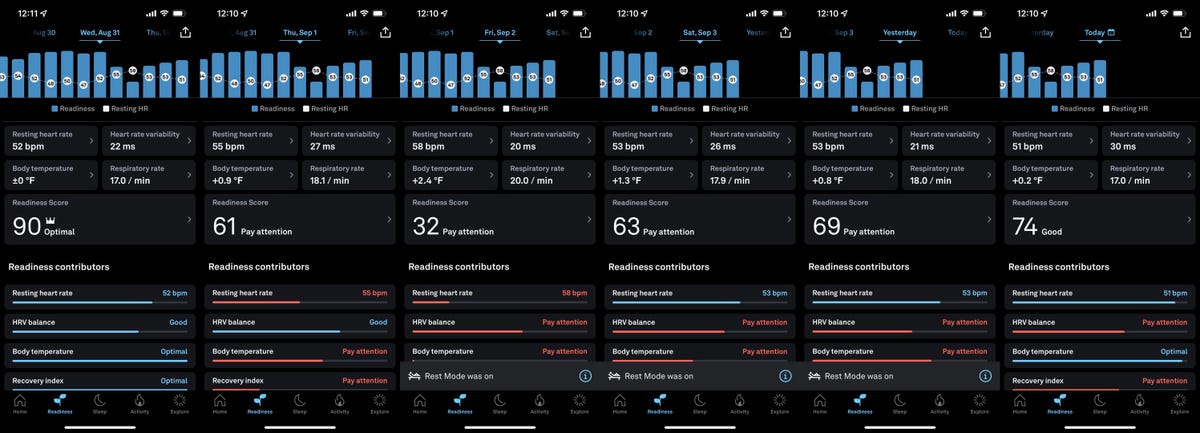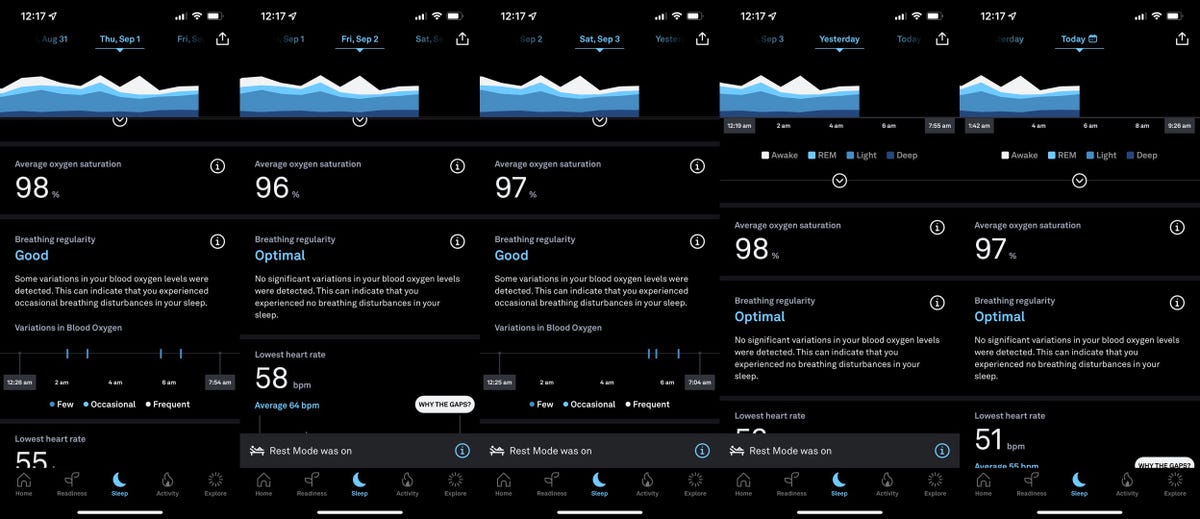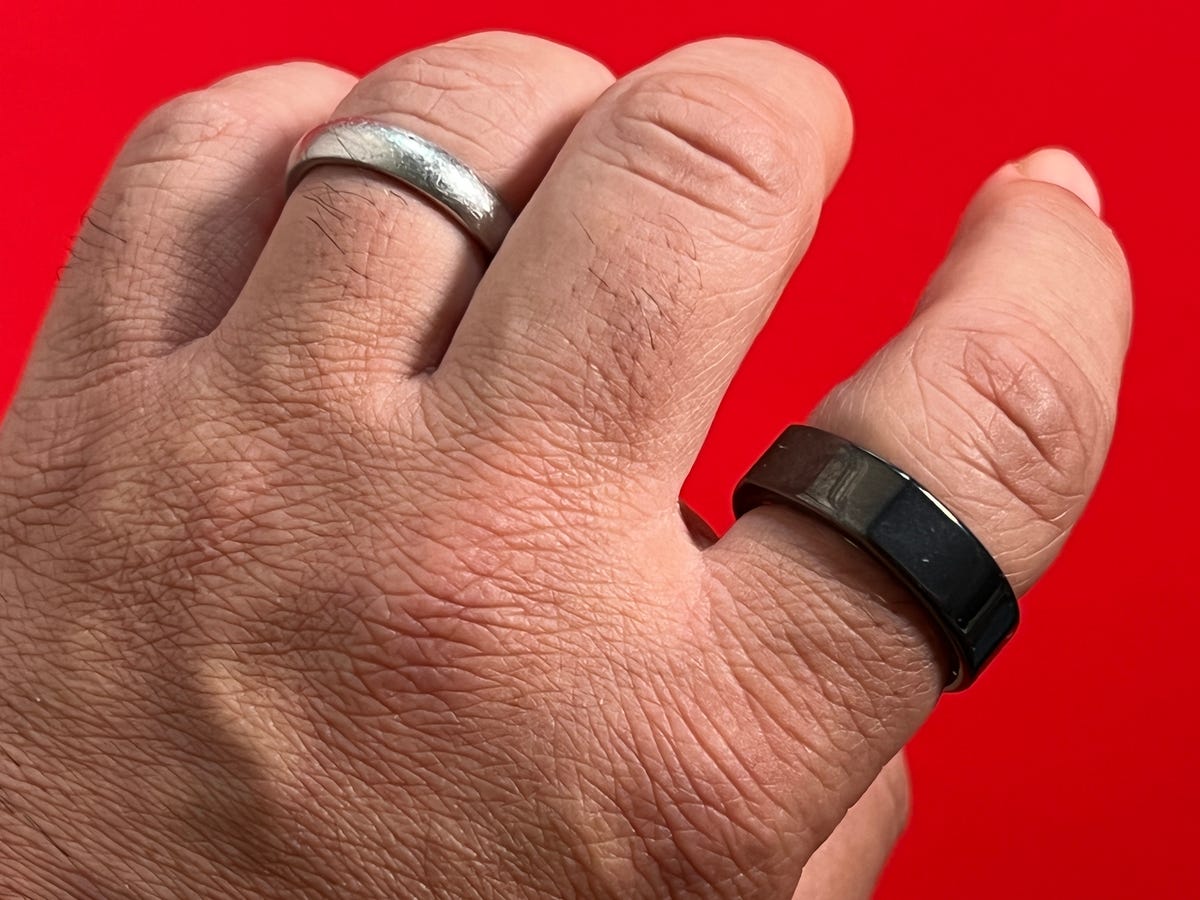My wedding ring, dull platinum, sits on the ring finger of my left hand. A black ring, titanium, sits on my right. The Oura Ring has been part of my hand for over half a year now — longer if you count the previous version I reviewed. I sleep with it. I shower with it. I don’t think about it much. And sometimes that’s exactly how I like my wearable tech. The Oura ring is a lot of things the Apple Watch isn’t, and also has a few things Apple’s next watch should adopt next.
Then, almost every morning, I check a phone app. It tells me my Readiness Score. It tells me my Sleep Score. I stare at these numbers and a pile of data below and I ask myself, do I feel OK today?
Read more: Best fitness trackers
The Oura ring is a weird wearable. It starts at $300 (roughly £260 or AU$445). It’s truly ambient. It’s invisible, in a sense. I don’t interact with it. It doesn’t have a screen. In a sense it reminds me of wearables from a decade ago, like the silver-disc Misfit Shine. I it doesn’t have a screen or readouts for me to study on the fly, but I still wear a smartwatch. In that sense, the Oura ring is already redundant. But it manages to do something that the Apple Watch, at least, still doesn’t.
The Apple Watch, and many smartwatches, lean on activity and “ring completion” goals. Walk a certain amount, stand a certain amount, do a certain bunch of stuff. The Oura ring has completion goals, but a lot of its daily metrics are holistic: Does it look like you’re doing OK today? Does that affect how you plan your day? The idea of Readiness Scores are creeping across the smartwatch landscape, but Apple in particular hasn’t adopted them yet.

Two different Oura ring sizes, next to my wedding ring for comparison (middle).
Scott Stein/CNET
The Oura ring is proactive, with a readiness score that suggests ways for you to take on the day ahead. The Apple Watch tends to look back at how my day was. Fitbit’s fitness and health metrics have shifted more to the Oura model, and I expect others to as well. Or, at least, to augment the experience with more holistic data. The Oura ring will flag if my temperature seems elevated recently, or my breathing rate changes, or my nightly blood oxygen seems to have shifted or my resting heart rate has been rising or falling. These could mean I’m getting sick. Or maybe I need rest. Or maybe it’s just a false alarm.
Just a few days ago, I got sick with some sort of cold, and a fever. The Oura ring noted my breathing rate increasing overnight, my temperature being higher. It suggested I switch to rest mode for the day. I took a COVID-19 test, but I didn’t need the ring to tell me that. (It was negative.) Still, having an app that’s aware that you might be sick can be useful feedback, and I’ve been noticing which stats change when I’m not feeling well.
In fact, my recent bad cold was a great test of how the Oura 3 worked to track my measurements. I’ve shared what the app showed shortly before, during, and after my bad cold. You can see some of the changes, especially in respiration rate, relative temperature, and resting heart rate.

My Readiness Scores in the Oura app, before, during, and after the cold hit.
Scott Stein/CNET
Sleep scores, meanwhile, also showed changes. Sleep tracking with the Oura ring works similarly to other watches and trackers, and over time I have found it correlating pretty well with how rested I felt the next day — of course, I didn’t track this against any more formal sleep measurement system, so it’s completely relative.

Sleep scores during my few days of having a cold.
Scott Stein/CNET
I waited over half year to review the Oura 3 because, when I first started wearing it last year, nothing much had changed. The ring, which adds extra red and green heart-rate sensing LEDs and an improved skin temperature sensor, promises to have richer data than the previous Oura ring. But at release the Oura 3 otherwise functionally the same as the Oura 2.

The Oura ring’s optical heart rate sensors are inside. The Gen3 ring has red and green LEDs for better sleep tracking and blood oxygen estimates.
Scott Stein/CNET
Long-promised blood oxygen measurements have finally arrived, thanks to a recent firmware update. These are taken overnight, and show up as a percentage rating the next morning in your overnight sleep data results: I’ve gotten numbers ranging from 97% to 99%.

My Oura app’s blood oxygen readings, during my same sick period recently.
Scott Stein/CNET
Another readout estimates how “optimal” your blood oxygen levels were over time, and whether any drops in blood oxygen seemed to have occurred, but it doesn’t get into specifics. Rings and watches can’t be as reliable a source of blood oxygen information as finger-worn pulse oximeters, although Oura believes its ring can come close. Over the last handful of weeks, my readings have largely seemed fine. I’m not sure I trust it, though.

The preferred way to wear the Oura 3, on my index finger. Super weird. (Wedding ring on ring finger for comparison). I swapped to a ring finger size since and it seems fine.
Scott Stein/CNET
Oura’s third-gen ring is apparently most effective when worn on the index finger, which is a weird proposition: It makes me look like a street magician. I’ve worn one on my ring finger, instead, and seem to be getting results that are fine. Unlike a smartwatch, the Oura ring has to be sized to your finger, which means picking which finger you’d prefer and sticking with it. I exchanged the first ring I wore on my index finger for a ring finger-sized one. It’s also worth noting that your ring size may change over time if you’re gaining or losing weight, working out or due to humidity (mine does). Rings can’t be adjusted as easily as watches can, and rings can sometimes get in the way of certain fitness and sports activities. The Oura Gen 3 ring can track heart rate during active workouts, but it’s not nearly as comfortable to use as a watch… and you can’t glance at your live readings on the ring.
The ring’s battery life seems to last around four days, which is great but it’s also tricky. I prefer multiday battery life to daily-charge devices like the Apple Watch, but when you’re out of a daily charge habit, figuring out when to charge becomes a challenge. The Oura ring still has no low-battery reminder other than an app notification that can pop up (and get lost) on your phone. I find the ring can go dead for a few days and I won’t even notice. I wish there were some sort of small battery indicator light on the ring.

The Oura ring charger. It’s USB-C compatible, but you need that contactless base to charge up.
Scott Stein/CNET
The other thing to know about Oura’s ring is that it needs an extra subscription. Oura’s subscription fee is $6 a month, on top of $300 or $400 for the ring, depending on whether you’re getting it in the less expensive silver or black, or step-up matte black Stealth or gold finishes. Paying $300 for a ring feels like a lot considering you can get a full-featured smartwatch at the same price. But it’s the subscription creep I don’t like, even though original Oura ring owners can get the ring upgrade subscription-free, and the ring comes with six months of the subscription for free. Fitbit already has a close-to-essential Premium service for its trackers and watches, and Apple leans on its Fitness Plus service. Amazon has a similar model for its Halo health trackers. This might be the future of wearables. Fitbit’s watches and services also mirror Oura’s: You can get a similar experience, especially if you’re wearing a temperature-monitoring Fitbit Sense.
I love the daily sleep and wellness scanning of Oura’s ring, because it’s exactly the type of analysis that’s missing from the Apple Watch. But that might be changing soon, as Apple’s expected next-gen watch possibly adds longer battery life and temperature sensing, too. Fitbit’s new Sense watch and Samsung’s latest Galaxy watches are moving in similar directions. Oura feels like a predictor of wearable tech’s future, but like many first movers, it may not always be where people end up.




